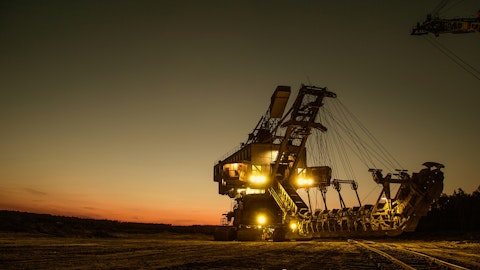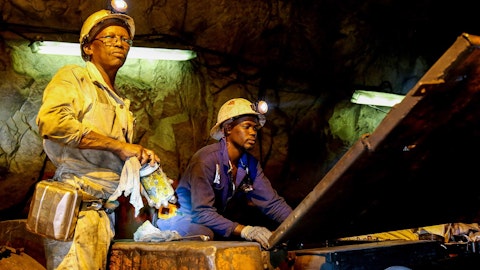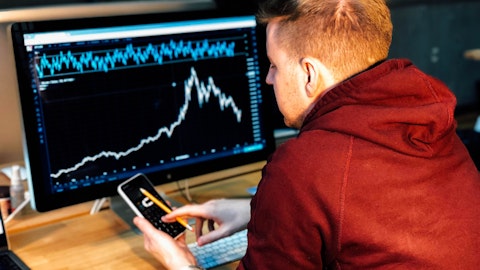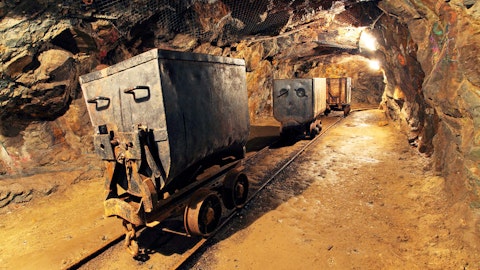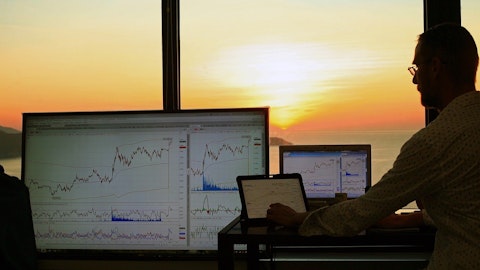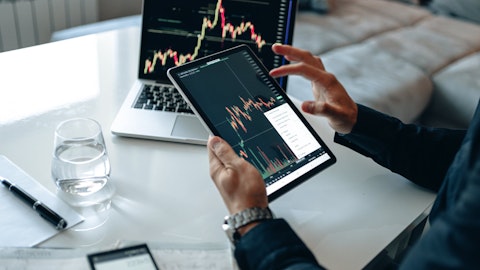Freeport-McMoRan Inc. (NYSE:FCX) Q4 2022 Earnings Call Transcript January 25, 2023
Operator: Ladies and gentlemen, thank you for standing by. Welcome to the Freeport-McMoRan Fourth Quarter Conference Call. At this time, all participants are in a listen-only mode. Later, we will conduct a question-and-answer session. I would now like to turn the conference over to Ms. Kathleen Quirk, President. Please go ahead, ma’am.
Kathleen Quirk: Thank you, and good morning. Welcome to the Freeport-McMoRan conference call, and happy 2023 to everyone. Earlier this morning, we reported fourth quarter 2022 operating and financial results, and a copy of our press release and slides are available on our website at fcx.com. Our conference call today is being broadcast live on the internet, and anyone may listen to the call by accessing our website homepage and clicking on the webcast link for the conference call. In addition to analysts and investors, the financial press has been invited to listen to today’s call, and a replay of the webcast will be available on our website later today. Before we begin our comments, we’d like to remind everyone that today’s press release and certain of our comments on the call include forward-looking statements, and actual results may differ materially.
Like to refer everyone to the cautionary language included in our press release and presentation materials and to the risk factors described in our SEC filings. On the call today with me are Richard Adkerson, our Chairman of the Board and Chief Executive Officer; Maree Robertson, our CFO; Mark Johnson, our Chief Operating Officer of Indonesia; Josh Olmsted, who is our Chief Operating Officer for the Americas; Mike Kendrick, who leads our molybdenum business; Cory Stevens, who heads our Engineering and Construction and overall Global Technical Services Group; Rick Coleman, who is actively involved in all of our construction projects, as well as Steve Higgins, our Chief Administrative Officer. So, we have a full complement of management team here today.
And we’ll start — Richard will make some opening remarks, and then he’ll turn it back to me and we’ll cover the slide materials, and then we’ll open up the call for your questions. Turn it to you, Richard.
Richard Adkerson: Yes. Thanks, Kathleen. Thank you all for joining us today. As Kathleen said, after my overview remarks, which will be brief, she will review our results for the quarter. It was a strong fourth quarter. The numbers speak for themselves. It reflects the performance of our global team, and I much appreciate everybody’s hard work. I read one of you said this morning in a report, mining is a tough business, and it certainly is. Nobody knows that, I think, better than me. But what we’ve done and is reflected in our results for 2022 and particularly the fourth quarter, is remarkable. Most of you, who know our business and maybe all of you do, recognize the need to look at Freeport into two major segments. Our operations in Indonesia by PT Freeport Indonesia is characterized by very large volumes, very low cost because of the grades and the gold content, largest gold mine in the world is a byproduct.
As you’ll see in the fourth quarter, it operated as the world’s second largest copper mine with a net unit cost of $0.06 a pound. Our business in Americas is quite different. We have among the largest mines in the world, the mines have low grades, there’s much more material to be processed, to be mined in process to recover the copper, and it’s an operation that gets challenged by low copper prices and factors like inflation. But when you look at the results and what our team has done this year, it’s been very positive. It’s also characterized by having some large future brownfield expansion opportunities, which is particularly meaningful given the situation of the copper in the world. Indonesia, it was just rock solid performance. We’ve been operating underground there for 40-plus years now.
We’ve been investing in the current underground operations that we have been ramping up over the past three years to become the largest underground mining operations in the world for the past 25 years. It just reflects the long-term nature of our business. The last three years have really been notable. We completed mining the Grasberg open pit, which had been the bulk of our operations since the discovery of the ore body in the late 1980s. We completed mining that pit at the end of 2019. Then early in 2020, we faced COVID. And for years, this transition was viewed as a risk overlying Freeport’s business. And it’s just a major accomplishment that we’ve reached our targeted mining and metal production targets that is what’s arguably the most complicated mine in the world.
And it’s all results of the hard work and accomplishments of our team there, very proud of them. The Americas business has done very well in meeting the challenges that we’ve had there, dealing with inflation, dealing with a period of low copper prices, we have issues that are challenged in terms of getting workers for our operations in the Americas. Our operation in Peru was facing a severe challenge with COVID that they manage very well. The political situation in Peru right now is very complicated. There are protests throughout the country. Our team is doing very well. We are continuing to manage housing, feeding our people and continuing our operations. We are slowing down a bit to make sure we have supplies for the long run, but we have support by our workforce and fundamental support for our business by the local community there because we’ve established such a great relationship with them.
So we are — as we look out now trying to predict short-term copper prices is very difficult. We actually don’t even try to do it ourselves. We deal with short-term negative movements when they occur by having a strong balance sheet and a conservative financial policy. It’s actually good to see right now that market sentiment going into 2024 is much improved over the end of — going into the fourth quarter. But we are on the outlook for the well-known risks that the world faces today, and we’re prepared to deal with it. We are a long-term business. And we — everything we do is focused, not on the short run other than to protect ourselves by having a strong balance sheet, managing our business in the right way, but our success is going to be measured over the long run.
And copper’s long-run outlook is increasingly positive based on fundamentals of demand and supply. We committed to copper 20 years ago when we were a single asset company, the rationale for acquiring Phelps Dodge more than 15 years ago is being reinforced today by the combination of this really special mine we have in Indonesia and the global operations and growing operations that we have in the Americas. It was the right decision 20 years ago to focus on copper and is the right decision now. Kathleen?
Kathleen Quirk: Thanks, Richard. We’ll start on slide 3, which summarizes our performance for the full year 2022. And just a couple of notes on the fourth quarter from our press release. We finished the year with a strong fourth quarter. Copper and gold sales exceeded our October guidance. And our consolidated unit net cash costs of $1.53 per pound in the quarter were better than our estimates going into the quarter. With average copper realizations in the fourth quarter of $3.77 per pound, we generated strong margins with fourth quarter adjusted EBITDA at approximately $2.25 billion. Looking at the year, we are proud of the performance of our team stayed focused on effective execution and on driving results in a volatile macroeconomic environment.
After successfully growing our volumes in 2021 by 19% for copper and 59% for gold compared with 2020, we achieved another year of growth in 2022, with 11% higher copper sales volumes and a 34% increase in gold volumes. Our team in Indonesia has successfully and materially grown production levels and a sustaining large-scale, low-cost production at the world’s largest underground mining complex. In the Americas, our teams in Peru and Chile proved resilient in restoring production during 2022 that had been impacted by the pandemic. And our teams in the U.S. maintain production at 2021 levels despite ongoing labor shortages and we also made significant advances on new technologies to enhance value. For the year, we generated $9.5 billion in adjusted EBITDA, and that was a year of dramatic swings in commodity prices and cost drivers.
Our operating cash flows for the year, which were net of $1.5 billion in working capital requirements was in excess of our capital investments in our operations, and we nearly tripled our cash return to shareholders, pursuant to our performance-based payout policy. We ended the year with net debt, excluding the debt associated with our smelter of $1.3 billion, and that’s substantially below the level of mid-2021 when we initiated our performance-based payout policy. On slide 4, you’ll see we’ve listed notable accomplishments during the year. In addition to driving value in our operating and financial areas of achievement, we’re very proud of our work with third parties to validate all of our operations under the Copper Mark standards, the measurable progress we’re making on our climate initiatives and the expanded disclosures we’ve developed to enhance transparency and accountability.
We’ll talk about markets next, and we’ve got a slide on page 5. We experienced significant volatility as many of you have seen during 2022, with copper prices trading from a high of $4.87 per pound earlier in the year, falling to $3.18 per pound midyear and partially recovering to $3.80 per pound by year-end. Prices continued to move higher in early 2023 to a level currently approximating $4.25 per pound as several of the macroeconomic clouds began to lift. We discussed on prior calls that the dramatic moves in 2022 have been largely — been based on sentiment rather than fundamentals. The facts are that the physical markets for copper have remained tight even during a period of weaker economic data coming out of China, and that’s evidenced by the low levels of available copper inventories throughout the year.
At the same time, copper’s importance in the economy continues to grow as a result of the intensity of use in clean energy applications and the global acceleration of electrification. We believe we’re still in the early innings of a broad-based secular driver of long-term demand. The ability of the industry to meet this multiyear period of growing demand continues to be challenged, leading to large market deficits in the future. You read about these challenges every day, and it’s getting harder, not easier, higher long-term prices are needed to incentivize new supplies. We’ve lived through the ups and downs in the copper market. We’ve effectively managed our operations and balance sheet during periods of volatility, and we’re prepared for this, but we believe the long-term fundamentals point to a real step change in how copper is valued in the economy.
Turning to our reserve position on slide 6. We benefit from a geographically diverse high-quality portfolio of copper mines with significant exposure to gold and molybdenum. Our strategy, as Richard discussed, is centered around being foremost in copper. And we benefit from a portfolio of assets with characteristics that are very difficult to replicate. We show our reserve position at the end of 2022 with over 100 billion pounds of proved and probable reserves. We have an average reserve life of over 25 years. We added twice the amount of reserves we produced in 2022, principally at our U.S. mines in the Morenci and Safford Lone Star districts where we’re focused on future growth. In addition to proved and probable reserves, we have enormous mineral resources of 235 billion pounds of copper.
Over half of this is located in the U.S. where we have established operations, a great track record and a valuable franchise. We’ll continue to work as we go forward to convert these resources into viable mine plans and future production. It’s an extraordinarily valuable resource position in a world that’s going to need more copper in the future. We wanted to focus a little bit on molybdenum on this call. And on slide 7, we’ve got some information about our molybdenum business. We’re a leader in that industry. We’re the world’s largest producer by a significant margin. And with the price move over the last couple of months of over 50% in molybdenum, we thought you’d be interested in learning more about our business. We produced 85 million pounds of molybdenum in 2022, and that’s comprised about 60% from copper mines as a byproduct and the balance from two primary molybdenum mines that we operate in Colorado.
And these are the only primary molybdenum mines that are currently operated in the United States. We also operate downstream processing facilities to produce products that are used in a broad range of metallurgical specialty steel and chemical applications. The price move from $18 per pound at the start of the fourth quarter to over $30 per pound currently has been driven by some of the same supply issues that have impacted copper. And in addition, demand drivers continue to be supported from the oil and gas, aerospace and power generation sectors. So, we note on this slide, the impact of a $5 change in molybdenum prices, it’s material at $400 million in annual EBITDA and $375 million in cash flow. And the recent move of over $10 per pound, if sustained at a higher price, adds additional leverage to our results.
Looking at our operating stats for 2022 on slide 8, you’ll see our sales for the year were about 35% from the U.S., 28% from South America and 37% from Indonesia. In the U.S., our sales were similar to 2021 levels, and we grew sales volumes by 10% in South America and by 20% in Indonesia. In the U.S., we’re continuing our focus on productivity, given the current limitations on adding to our workforce, we’re taking advantage of technology advancements and opportunities to expand production from leaching at low incremental cost, and we’re planning our next phase of growth, as we’ll talk about in a few minutes. As discussed, the biggest resource position and source of long-term growth we have is a real opportunity in the United States. In South America, both Cerro Verde and El Abra grew production in 2022 in a complex social and political environment.
After successfully recovering from the pandemic-related interruptions in 2022, our team in Peru is now dealing with challenges associated with civil unrest that you’ve all read about. We’re prioritizing the safety and security of our workforce. We’re navigating disruptions to transportation routes and supply chains. To date, the impacts have not been significant but the situation is dynamic day by day, and we’re watching it very carefully. The bottom of the chart shows the 2022 cost performance. As we’ve talked about on prior calls, we experienced significant inflation pressures across the business during 2022, particularly for energy and other commodity-related consumables, and in the second half of the year, started to see inflation from a rising cost of materials, supplies and services.
The situation started to improve in 2022 with a number of the commodity-related consumables, but we’re still dealing with costs in excess of historical levels. If you look at the average cost for the year at Grasberg of $0.09 per pound is remarkable, particularly in the context of this cost environment. Richard talked about the significant success story of the Grasberg transition, and we’ve got some details on slide 9, significant success for not only Freeport but also something for the global mining industry to be proud of in the country of Indonesia. We started planning for this transition over 25 years ago, and the team has just done an outstanding job. We benefit from the fact that several from the team who were involved in the planning of this project, including Mark Johnson, who’s on this call, stayed with it over this period.
And over the years, we’ve added great talent to our team with experts from around the world. The success of this project, the mutual respect built over the years between Freeport, the government of Indonesia and local communities has established a really strong foundation for the future. We’ve got the opportunity with this resource to plan a new phase of development longer term and are continuing to discuss with the government the opportunity to extend our long-term partnership beyond 2041. If you go to slide 10, we’ve got an update on our smelter project. And this is our key feature of our commitment to the Indonesian government, was to expand domestic copper smelting and refining capacity in Indonesia. We’re making really good progress on constructing the new smelter in Eastern Java, it’s near our existing smelter, PT Smelting at Gresik.
You can see from the pictures that construction is advancing. We’ve got thousands of workers now on site. We’re working very closely with our EPC contractor to try as much as possible to make up delays that were caused by the pandemic. We reached a milestone of over 50% completion recently and we are expecting to begin commissioning the smelter during 2024. As you recall, the capital investments for this project are being funded from a successful bond offering that PT-FI completed during 2022. And so, we have the funding between the bond offering and a revolver at PT-FI to fund this project. Moving to our growth outlook. This is exciting opportunities for the Company, and we continue to plan our next phase of growth. We’ve got benefit from having multiple organic projects to develop within the portfolio over time.
We operate all the mines we have interest in. We’re able to share experiences, new technologies, operating synergies and best practices across the portfolio as we develop projects, and we can direct capital across the portfolio to the highest value opportunities. Our proven technical capacity capabilities and management is a notable strength. And importantly, we’ve earned a track record and a reputation for operating sustainably and responsibly. The world, we believe, is going to need all of our projects and more. The project with the shortest lead time is our Americas leach initiative. We’ve talked a lot about it in recent calls. The economics are compelling, low capital intensity, low incremental operating costs and a low carbon footprint.
The new data analytics capabilities, we are continuing, to be applied to prioritize our work streams on the highest value. We’re continuing our work to apply covers to the leach stockpiles because of the benefits that you get from heat retention in enhancing recoveries, and we’ve identified new areas that were not pursued historically. We’re also continuing to test various additives that can further enhance recoveries. This is a really significant opportunity for us. We’re continuing to target a run rate of 200 million pounds per annum by the end of this year and success of this level — at this level would provide opportunities to scale larger. We’re in a great position to lead this innovation with our long history in leaching and large inventory to work with.
At our Bagdad mine in Northwest Arizona, we’re progressing a feasibility study to double production at that site. We expect to complete the feasibility this year, and we’ll be in a position to assess options on how we time the future development. We started advanced planning to commence construction of a new tailings site that would support the existing operation, but would also provide flexibility for the expanded production. And as a brownfield expansion, this project could be developed more quickly than a greenfield development. Our Lone Star opportunity is really something special. We’ve been successful in increasing production levels substantially above the original project. And we’re really in the early stages in the development of this mine, as we mine the oxide ores more quickly, we’re opening up the opportunity for a major sulfide development long term.
The resource is massive. You’ve seen the numbers, 50 billion pounds of potential resource here. We’re doing a lot of drilling. And importantly, it’s located in an established mining district in the U.S. In Chile, we’ve defined the opportunity for a major expansion at our El Abra mine. As we continue to monitor regulatory and fiscal matters in Chile, we’re planning a project to invest in infrastructure, water infrastructure to provide flexibility to extend existing operations and optionality to support a new concentrator. We’re also planning at El Abra to test new leaching technologies in the near term, to evaluate the potential for expanded leach production and possibly competing technologies to a concentrator. We’re continuing our development of the Kucing Liar deposit in Indonesia.
We’re really gaining a lot of efficiencies from the work we did at Grasberg Block Cave. And similar to that development, this is a long-term project. We expect to have initial production from Kucing Liar deposit towards the end of this decade. Moving to slide 12. We provide a three-year outlook for our sales volumes. And as we talked about, we achieved two years of growth in copper sales. And currently, our forecast reflects sales in the 23 to 25 period that are similar to 2022 levels. Our mine production is actually going to be higher than our sales by about 100 million pounds in 2023 and 2024. And that is a result of our domestic processing arrangements in Indonesia where the point of sale has changed from selling concentrate to selling cathodes.
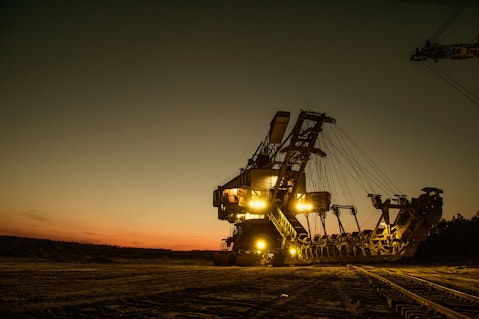
Pixabay/Public Domain
And so, a portion of our production will be inventoried until it’s processed and sold through our smelters. Previously, this inventory would have been held by third-party smelters. We’ve got small revisions otherwise to 2023 guidance that reflects assumption of a continuation of tight labor markets in the U.S. That’s impacted our ability to increase mining rates. And success also in our leach recovery initiative could provide some upside in the U.S. as we look over the next three-year period. In the reference materials on slide 30, we provide information on our 2023 sales by quarter. The reason for the drop in the first quarter reflects the impact of the tolling arrangement in Indonesia. But, you can see the balance of the year is fairly stable at over 1 billion pounds of copper sales per quarter.
Moving to the cost outlook for 2023, we’re providing guidance of average cost of $1.60 per pound for the year. That compares with $1.50 per pound in 2022. We show a comparison to the two years, and you’ll see the site production cost line item is about 4.5% higher than the 2022 average. And that’s a result of assumptions that we’ve made in our forecast for higher average electricity and coal costs compared with the 2022 average and also higher power requirements, principally in Indonesia, and the impact of higher cost of equipment components, supply costs and labor cost increases. The other line items are offsetting. You’ll note a decline in royalties and duties. That really is reflective of a recent reduction in our export duty in Indonesia as a result of the smelter progress.
I’ll also note that this assumes a molybdenum price of $20 per pound in 2023. The current price is $30 a pound and each $2 per pound change in molybdenum is $0.02 a pound. So, if current prices hold, would have roughly $0.10 a pound less cash — unit net cash costs and this reflects. In recent months, inflationary pressures have been less severe than we experienced during 2022. We’re encouraged by that. And we’re going to continue to focus on managing costs that we can control. We’re continuing to pursue technology-driven enhancements to mitigate the impacts, particularly in the U.S. Getting to our cash flows, significant leverage to copper prices. We’ve got on slide 14, we show modeled results for EBITDA and cash flow at various copper prices ranging from $3.50 per pound to $5 per pound copper.
These are modeled results and we use the average of 24 and 25 with current volume and cost estimates and holding gold flat at $1,900 per ounce and molybdenum flat at $20 per pound. And you’ll see here that annual EBITDA would range from nearly $9 billion per annum at $3.50 copper, to $15 billion per annum at $5 copper. And our operating cash flows would range over these prices from $6 billion at $350 copper to $11 billion at $5 copper. And we show sensitivities to various commodities on the right and input costs. With our long-life reserves and large-scale production, we’re well positioned from future — to benefit from future metals intensive growth trends with prospects for increasing cash returns under our performance-based payout framework.
Our capital expenditure plans are summarized on slide 15. The capital expenditures totaled $2.7 billion, excluding the smelter in 2022. We’ll note that this was lower than the $3.3 billion estimate we provided going into 2022, and that reflects lead times and our focus during the year to prioritize critical projects. The current forecast for 2023 totals $3.4 billion, and that’s a slight change from our previous estimate of $3.3 billion for 2023. And capital expenditures for 2024 currently forecast to approximate $3 billion as spending on the Grasberg projects reach completion. We always are very careful in managing our capital cost to maintain flexibility in response to market condition, while ensuring that our investments are sufficient to support a reliable long-term production profile.
Returning to the financial policy that we began to implement in the second half of 2021, it’s really centered on three priorities. The cornerstone of the financial policy is maintaining a strong balance sheet and liquidity. And that provides significant flexibility for the future. We’ve been executing on this performance-based payout. It provides for 50% of our free cash flow to be allocated to shareholder returns in the form of dividends and share purchases and the balance available to invest in our projects. Since commencing the performance-based payout policy in the second half of 2021, we’ve returned about 60% of our free cash flow to shareholders through dividends and share purchases. And at the same time, we also further strengthened our balance sheet, providing capacity for funding new projects over time.
We did not purchase shares in the second half of 2022 because of the significant change in market conditions and the resulting impact on cash flows in the second half of the year. The improved market conditions will drive increased free cash flow, which will boost shareholder returns, and our future discretionary share purchases will be dependent on our cash flow and overall market conditions. We believe the three priorities of balance sheet strength, allocating cash flows to a mix of shareholder returns, and organic growth will enhance long-term value of our business. In closing, I just want to reiterate our view about the positioning for the Company, a bright long-term future supported by our attractive portfolio of assets, supported by the fundamentals of the copper business and the positive outlook for the markets we serve.
Our team is energized. We’re motivated to continue building long-term value in our business and on executing our plans responsibly, safely and efficiently. And I want to thank you for your attention, and operator, we’ll now open the call for questions.
See also 18 Countries that Produce the Most Nuclear Energy and 15 Stocks That Have Increased Dividends for 25 Years.
Q&A Session
Follow Freeport-Mcmoran Inc (NYSE:FCX)
Follow Freeport-Mcmoran Inc (NYSE:FCX)
Operator: Our first question will come from the line of Emily Chieng with Goldman Sachs. Please go ahead.
Emily Chieng: Good morning, Richard and Kathleen. And thank you for taking my questions. I would like to sort of ask around Freeport’s growth appetite. And as you think about the copper price environment and how the market is trending, has anything in your mind changed around how you view Freeport’s need to pursue or accelerate growth plans? There’s clearly been a lot that has changed in the broader macro environment as well. And I wouldn’t mind hearing about how maybe some of the leaching opportunity can play into that and what the potential annual run rate basis could look like when fully developed? Thank you.
Richard Adkerson: Thanks, Emily. With leaching, we’re not constraining ourselves to conserve capital or anything else. We’re — we believe this is such a great opportunity for us that we are pursuing it as aggressively as we can, and we are pursuing it on a number of different fronts, some using outside vendors, some doing things on our own, some in joint ventures with companies. It’s just such a great opportunity to add production at low capital cost and with low carbon. So, it’s not something we’re constraining. The other projects that we have, and Kathleen reviewed them, we have a series of major capital projects that are multiyear large capital requirements. And for those, we are working hard to prepare ourselves for them and doing work so that we can go forward.
But we are going to wait until the uncertainties that we’ve been facing recently are — become clearer. As I said, the current sentiment is much stronger than it was three months ago, but there’s still a lot of overhang in the market, as you can see in the market today. So, we are waiting to see that our project in Chile is dependent on the direction the country goes in with this current consideration of its laws and its constitution. So, that is really going to be on hold until that becomes clear. So, we’re not preparing any major change in the first part of 2023 versus what we did in 2022.
Kathleen Quirk: Emily, on the leaching run rate, the 200 million pound target that we’ve laid out, those — we believe that that can be attained just from these operational changes that we’re making. The heat retention, leaching in places that we weren’t leaching previously, directing the solutions to places where we can enhance recoveries really from data analytics that we’re getting that are helping us — helping guide our operations every day. Those things we think we can get just operationally. The — on top of that, this research and development that’s going on with respect to additives, that could scale it larger. So, this 200 million pounds that we’re talking about, we think that is really just bringing more of a light on our leach stockpiles and moving aggressively to — over the last several years, the focus on the industry has been more on concentrating.
And now we’re putting focus back on these leach initiatives, and we’ve identified some things. I wouldn’t say low-hanging fruit, but it’s achievable things that we’re doing, and we’re already starting to see results.
Operator: Your next question will come from the line of Orest Wowkodaw with Scotiabank.
Orest Wowkodaw: Just given the uncertainty out there with respect to both Chinese and ex China markets, can you give us an updated outlook on what you’re seeing from your customers? Like are you seeing any indications of slowing demand?
Kathleen Quirk: Richard, do you want me to take that? Orest, we’re not — I mean, there’s pockets — of course, in the residential markets there’s pockets of weakness, but there are — we’re just continuing to see strong physical demand, we’re selling everything that we can produce. And there’s no ability for us to, at this point, produce more that customers are looking for. So, on balance, I’d say the physical market continues to be healthy, and we have — most of our insights come from within the U.S. because we’re a very significant part of the U.S. marketplace. And — so generally, the market is continuing to be strong, and we’re selling everything that we can produce. And if we could produce more, our customers would want it.
Richard Adkerson: Even looking back to 2022, you’ll recall, I mentioned I think on more than one conference call that there was a disconnect between even then the physical world we were dealing with, with our customers and what the market was doing. So, it has been striking as to the strength of demand that we’ve had, we had no problem selling our production. We’ve actually — there was a shortage of wire rod in the United States that was — where we couldn’t meet everything that was being produced. And then, with our copper concentrate customers, including China, people were buying all that we produced and actually wanting more. So, market sentiment is better now. And but our customers continue to be very positive.
Operator: Your next question will come from the line of Chris LaFemina with Jefferies. Please go ahead.
Chris LaFemina: You have $1.3 billion of net debt as of the end of 2022. Your net debt target range is $3 billion to $4 billion. So, I guess, the first question is, is that the range that we should think about? Are you comfortable maintaining net debt below that range? In other words, if you really want to get to $3 billion to $4 billion, how do you get that from here, generating positive cash flow? You can step up the buybacks, maybe accelerate returns. But do we get to a $3 billion to $4 billion range this year, or is that not going to happen?
Richard Adkerson: Well…
Kathleen Quirk: The 1.3 — go ahead.
